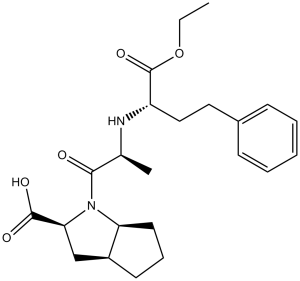Ramipril (HOE-498)
This product is for research use only, not for human use. We do not sell to patients.

For small sizes, please check our retail website as below: www.invivochem.com
| Size | Price | Stock |
|---|---|---|
| 2g | $250 | Check With Us |
| 10g | $750 | Check With Us |
| 20g | $1125 | Check With Us |
Cat #: V1783 CAS #: 87333-19-5 Purity ≥ 98%
Description: Ramipril (HOE-498; Altace; Carasel; Ramace; Zabien; Tritace; Ramace; Triatec; Tritace; Vesdil) is a potent angiotensin-converting enzyme (ACE) inhibitor with anti-hypertensive effects.
Top Publications Citing Invivochem Products
Publications Citing InvivoChem Products
Product Promise

- Physicochemical and Storage Information
- Protocol
- Related Biological Data
- Stock Solution Preparation
- Quality Control Documentation
| Molecular Weight (MW) | 416.51 |
|---|---|
| Molecular Formula | C23H32N2O5 |
| CAS No. | 87333-19-5 |
| Storage | -20℃ for 3 years in powder formr |
| -80℃ for 2 years in solvent | |
| Solubility In Vitro | DMSO: 83 mg/mL (199.3 mM)r |
| Water: <1 mg/mLr | |
| Ethanol: 83 mg/mL (199.3 mM) | |
| Solubility In Vivo | 30% PEG400+0.5% Tween80+5% Propylene glycol: 30 mg/mL |
| Synonyms | HOE-498; Altace; Carasel; HOE498; Ramace; Zabien; HOE 498; Tritace; Ramace; Triatec; Tritace; Vesdil; |
| Protocol | In Vitro | Ramipril (HOE-498) enhances the activity of ACE-associated CK2 and the phosphorylation of ACE Ser1270 in cultured endothelial cells, but is unable to activate JNK or stimulate the nuclear accumulation of c-Jun in endothelial cells expressing a S1270A ACE mutant or in ACE-deficient cells. Prolonged Ramipril treatment increases ACE expression in primary cultures of human endothelial cells and in vivo (mouse lung), which can be prevented by pretreatment with the JNK inhibitor SP600125 |
|---|
These protocols are for reference only. InvivoChem does not
independently validate these methods.
| Solvent volume to be added | Mass (the weight of a compound) | |||
|---|---|---|---|---|
| Mother liquor concentration | 1mg | 5mg | 10mg | 20mg |
| 1mM | 2.4009 mL | 12.0045 mL | 24.0090 mL | 48.0181 mL |
| 5mM | 0.4802 mL | 2.4009 mL | 4.8018 mL | 9.6036 mL |
| 10mM | 0.2401 mL | 1.2005 mL | 2.4009 mL | 4.8018 mL |
| 20mM | 0.1200 mL | 0.6002 mL | 1.2005 mL | 2.4009 mL |
The molarity calculator equation
Mass(g) = Concentration(mol/L) × Volume(L) × Molecular Weight(g/mol)
Mass
=
Concentration
×
Volume
×
Molecular Weight*
The dilution calculator equation
Concentration(start)
×
Volume(start)
=
Concentration(final)
×
Volume(final)
This equation is commonly abbreviated as: C1 V1 = C2 V2
Concentration(start)
C1
×
Volume(start)
V1
=
Concentration(final)
C2
×
Volume(final)
V2
Step One: Enter information below
Dosage mg/kg
Average weight of animals g
Dosing volume per animal µL
Number of animals
Step Two: Enter the in vivo formulation
%DMSO
+
%
+
%Tween 80
+
%ddH2O
Calculation Results:
Working concentration:
mg/ml;
Method for preparing DMSO master liquid:
mg
drug pre-dissolved in
µL
DMSO(Master liquid concentration
mg/mL)
,Please contact us first if the concentration exceeds the DMSO solubility of the batch of drug.
Method for preparing in vivo formulation:
Take
µL
DMSO master liquid, next add
µL
PEG300, mix and clarify, next add
µL
Tween 80,mix and clarify, next add
µL
ddH2O,mix and clarify.
Note:
- (1) Please be sure that the solution is clear before the addition of next solvent. Dissolution methods like vortex, ultrasound or warming and heat may be used to aid dissolving.
- (2) Be sure to add the solvent(s) in order.




































